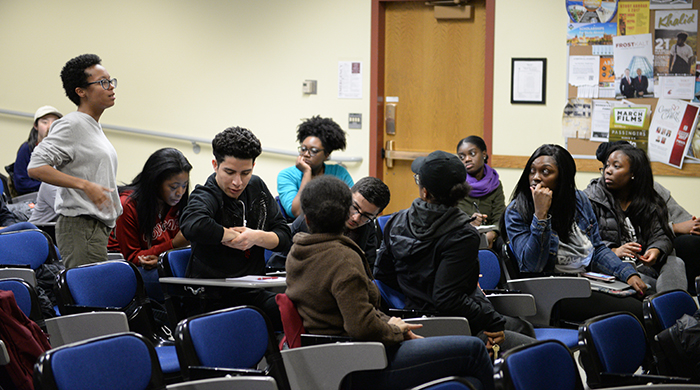Media ignores African Americans missing in U.S.
JESSIE DIEMERT | Daily Evergreen file
The Black Student Union hosted a forum to ask the ASWSU presidential candidates questions and raise concerns on Feb. 7.
April 4, 2017
Last week, a post claiming that 14 girls had gone missing in a matter of 24 hours in Washington D.C. went viral on social media. The hashtag #FindOurGirls was born out of alarm from the post.
Though there are conflicting reports on how much of the post was accurate, what is not inaccurate is the disproportionate number of women of color who are missing. In 2014, the Black and Missing Foundation reported that 64,000 black women and girls were missing throughout America.
In general, the lack of coverage on mainstream news media on issues afflicting the black population in America is telling of the kinds of bodies that merit attention. It is telling of the ways our society manifests its implicit biases.
Black Student Union (BSU) President Chijioke Emeka said in regard to the missing girls that the “lack of media coverage is a direct correlation to the lack of value our society places on black lives.” She also told me the BSU will be looking for the most effective way to bring awareness to this issue.
While America continues to receive notifications regarding Trump’s tweets and mishaps, young women are being kidnapped and trafficked.
Blacks, who made up only 13 percent of the population in 2013, made up 35 percent of the missing people, according to a Wall Street Journal analysis of the FBI data and Census population estimates.
Per usual, issues that seem national and universal are disproportionately affecting a group of Americans that is already low on our societal hierarchy and priority list.
Concern by the state or the media is only shown after people of color express outrage themselves.
“We also noticed that a lot of African-American children that go missing are initially classified as runaways,” Natalie Wilson, co-founder of the Black and Missing Foundation. “They do not get an AMBER alert or media coverage.”
Black comedian Patrice O’Neal said in his stand up “Elephant in the Room,” if he ever went sailing, he would take a white baby on a keychain with him in the off chance that he came up missing. His point was that as long as there was a white child with him, authorities would be more likely to search for him.
I have always admired comedians for their ability to shed light on important issues in our society using comedy. The saying, “there is truth in every joke,” certainly has some truth to it.
In “Missing White Woman Syndrome: An Empirical Analysis of Race and Gender Disparities in Online News Coverage of Missing Persons” by Zach Sommers, he refers to this phenomenon as the “Missing White Women Syndrome (MWWS).” His findings indicated that white women, in particular, appear “more likely to receive any news coverage and benefit from higher coverage intensity,” when they are missing.
D.C. Councilmember Trayon White said to HLN’s Michaela Pereira that, “what the community is alarmed about — we had a 10-year-old girl missing the other day, but there was no AMBER alert.”
The true concern that has emerged with this story is that when children of color disappear, authorities make the assumption that they are simply runaways or that, somehow, they have a hand in their own disappearance. This is in contrast to the amount of attention that white children are likely to receive when they go missing. This is manifested in whether law enforcement decides to send out AMBER alerts for missing children of color and how much time media outlets are likely to spend covering their stories, if they pick up the stories at all.
Basheera Agyeman is a junior comparative ethnic studies major from Accra, Ghana. She can be contacted at 335-2290 or by [email protected]. The opinions expressed in this column are not necessarily those of the staff of The Daily Evergreen or those of The Office of Student Media.

















